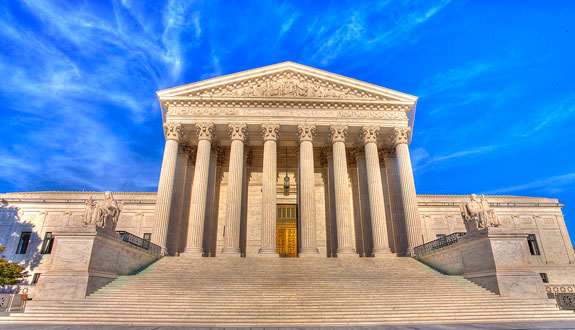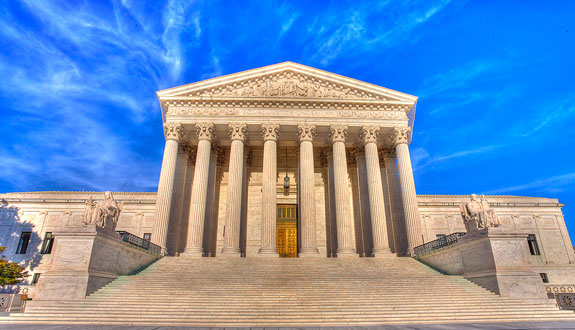3 Supreme Court Rulings That Should Interest Future Lawyers
- by
- Jun 27, 2014
- News, Supreme Court Rulings
- Reviewed by: Matt Riley


The Supreme Court is set to rule on a slew of big cases this week before ending its current term. Because these rulings—and the justices’ accompanying opinions—represent the most influential and important issues in the legal world, prospective law students would benefit from understanding the matters at hand. This time around, the court is addressing issues related to privacy laws, executive power, and more. This post will summarize several of these cases and describe their ramifications.
1) ABC v. Aereo
For context, Aereo is a television streaming service that allows subscribers to watch live, broadcast television on their computers, tablets, smart phones, and similar devices through the use of a small antenna. Naturally, this innovative service ruffled a few feathers from television providers, and several major broadcast companies sued Aereo for copyright infringement. They claimed that Aereo was rebroadcasting copyrighted material without paying a fee to do so. The Supreme Court ruled 6-3 against Aereo.
This ruling has far-reaching implications. For one thing, I won’t be able to binge watch Netflix (how good is season two of Orange is the New Black?) and watch live sports on my computer, which is a real shame. Beyond that, however, the Court is sending a somewhat troublesome message to the technology industry by limiting an innovative new service. The decision in this case is a death knell for Aereo and it may provide a disincentive for groundbreaking technological developments in the world of broadcast services.
This case revolved around the question of whether or not police need a warrant to search cellphones. In most cases, police are allowed to search anything they find on a defendant. The Obama administration (surprise, surprise) and, in this case, the State of California held that cellphones should no be different than any other item. The defendant claimed that cellphones, increasingly, contain a vast array of sensitive information and, as a result, should be afforded greater protection. The Supreme Court unanimously stated that police do indeed need a warrant to search cellphones.
The impact of this ruling is clear: the Supreme Court is sending a definitive message in defense of digital privacy. It should be noted that this decision has no impact whatsoever on the NSA and its ability to gather digital information, but it does suggest that the Supreme Court may, in future rulings, take a similar stand for digital privacy (just so we’re clear, I’m not saying the NSA’s digital information gathering ability should or should not be changed…I don’t want to get flagged…I’m a patriot!). Furthermore, the ruling runs contrary to criticisms that the Supreme Court is behind the times on issues pertaining to technology.
3) National Labor Relations Board v. Noel Canning et. al.
Although the name may not indicate it, this case boiled down to the application of executive powers—specifically, the president’s power to make temporary, recess appointments. In 2011, President Obama made several appointments to the National Labor Relations Board during a three-day break between senate sessions, justifying the appointments through a Constitutional provision. The Supreme Court rejected this position by saying that the Senate was not truly on recess, which must last for at least 10 days to be official according to Justice Breyer’s majority opinion, and, in a limited ruling, reduced presidential power to make temporary appointments.
The ruling’s impact is clear—the Supreme Court reigned in executive power. The Republican Party has been clamoring for action on this front for quite some time, and this can be seen as a validation for their criticism of President Obama’s unprecedented power grab. Looking to the future, this limit on executive power will become far more impactful if the Republican Party gains a majority in the Senate after the midterm elections (in the short term, the Senate’s ban on filibusters to block appointments somewhat waters down the importance of this decision). On an unrelated note, the ruling also reaffirmed the Court’s intense partisan split, as a broader limit to presidential power was rejected 5-4.
The Supreme Court’s recent rulings address a myriad of hotbed political issues, and I recommend that anyone interested in studying the law gain at least a peripheral understanding of the legal matters involved in these decisions. In doing so, prospective students will broaden their understanding of areas of legal contention and learn more about the practical application of legal study. Also, for the future gunners out there, you can probably impress your professors by quoting the justices’ holdings.
Search the Blog

Free LSAT Practice Account
Sign up for a free Blueprint LSAT account and get access to a free trial of the Self-Paced Course and a free practice LSAT with a detailed score report, mind-blowing analytics, and explanatory videos.
Learn More
Popular Posts
-
logic games Game Over: LSAC Says Farewell to Logic Games
-
General LSAT Advice How to Get a 180 on the LSAT
-
Entertainment Revisiting Elle's LSAT Journey from Legally Blonde








